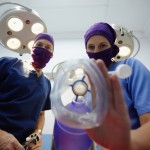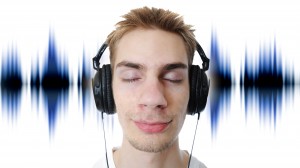
In the Woodland we have previously looked at musical interventions for agitation in dementia and depression. In June 2013 the Cochrane Collaboration published a systematic review of musical interventions for preoperative anxiety.
As may be expected, people awaiting surgical procedures often experience high levels of anxiety. This anxiety is important as it can result in negative bodily responses, such as increased blood pressure and heart rate, leading to slower wound healing and increased risk of infection. It may also affect the start of anaesthesia and slow down postoperative recovery.
To reduce patient anxiety, sedatives and anti-anxiety drugs are regularly administered before surgery. However, these often have negative side effects, such as causing drowsiness and breathing difficulties, and may interact with anaesthetic drugs to prolong patient recovery and discharge. Therefore, increasing attention is being paid to music therapy and music medicine interventions, amongst other non-pharmacological interventions, for reduction of preoperative anxiety.
This systematic review was completed to evaluate the efficacy of both music medicine and music therapy for reduction of preoperative anxiety as well as to identify variables that may moderate the effects.
Methods
The Cochrane review team searched all available databases and a large number of music therapy publications, checking reference lists of all relevant trials, contacting relevant experts for identification of unpublished trials, and including publications without restricting language.
All randomised and quasi-randomised trails were included that compared music interventions and standard care with standard care alone.
Interventions were categorized as ’music medicine’ when passive listening to pre-recorded music is offered by medical personnel. Music therapy requires the implementation of a music intervention by a trained music therapist, the presence of a therapeutic process, and the use of personally tailored music experiences.
Results
26 trials were included (2051 participants). All studies used listening to pre-recorded music. Most studies offered one 20 to 30-minute music session to the participants during the preoperative waiting period.
- female (54%) and male (46%) participants
- mean age of participants was 48.7 years of age. Trial sample size ranged from 9 to 327 participants with an average sample size of 78.9 (SD 64.36) participants
- Stait-Trait Anxiety Inventory (STAI-S) reduction was 5.72 units greater than standard care (95% CI -7.27 to -4.17, P < 0.00001)
- Using other anxiety scales there was a reduction of 0.60 standardized units greater than standard care (95%CI -0.90 to -0.31, P < 0.0001)
The results did also suggest a small effect on heart rate and diastolic blood pressure, but no support was found for reductions in systolic blood pressure, respiratory rate, or skin temperature.
One large study found that music listening was infact more effective than the sedative midazolam in reducing preoperative anxiety and equally effective in reducing physiological responses.
Conclusions
These results are consistent with the findings of three other Cochrane systematic reviews on the use of music for anxiety reduction with coronary heart disease patients (Bradt 2009), mechanically ventilated patients (Bradt 2010) and cancer patients (Bradt 2011).
There are now four Cochrane reviews supporting the anxiety-reducing effects of music for medical patients, with the fact that preoperative sedatives and antianxiety drugs often have negative side effects and may prolong patient recovery and discharge:
Cochrane suggest that music interventions should be offered to patients as an alternative to antianxiety drugs
Due to the nature of the music intervention most trials were assessed to be at high risk of bias because of the lack of ability to blind the participant, as ever this means that the results need to be interpreted with caution. Publication bias was examined visually in the form of a funnel plot which did not show evidence of publication bias.
In general, the trials that used listening to pre-recorded music included only limited information about the music selections used, except for mentioning general music styles (for example new age, classical music, easy listening, etc.). More research is needed to evaluate the effect of the variety of music and whether it is patient preferred or not. The different effects of music with different characteristics (tempo, timbre, harmony, emotional intensity, etc.) needs further study as does research into the effect of music therapy interventions. Finally, more detail is required as to whether there is an onward effect on wound healing, infection rate, time to discharge and patient satisfaction when using music interventions.
So, us Elves are off to plug into our generic music players and relaaaaaax…
Links
- Bradt J, Dileo C, Shim M. Music interventions for preoperative anxiety. Cochrane Database of Systematic Reviews 2013, Issue 6



People awaiting surgical procedures often experience anxiety, which can negatively impact blood pressure: http://t.co/1pOjaGvS1a
Music interventions to replace sedatives for preoperative anxiety? Analysis by @Mental_Elf http://t.co/0HDrGSDpcw via @sharethis
This Cochrane review found that music therapy reduced pre-operative anxiety symptoms: http://t.co/1pOjaGvS1a
Cochrane review finds that #music therapy reduces pre-operative #anxiety symptoms: http://t.co/OdfC5EglZn via @Mental_Elf
Anxiolytic effects of music during pre-operative waiting via @Mental_Elf & Cochrane review http://t.co/8PsIZ3sSCQ
RT @RobertVermeiren: Muziektherapie blijkt alternatief voor angstreducerende medicatie voor chirurgische ingreep. #cochrane review http://t…
Muziektherapie werkt, horen we bij de GGz Praktijk al dagelijks van clienten. Mooi dat er onderzoek is om te staven. http://t.co/srvBSay5Oa
#MusicPlease Muziek vermindert angst voor operatie. Mogelijk alternatief voor #medicatie. http://t.co/dC12Gi81NC #ggz via @RobertVermeiren
@MusicTherapyWks @Mental_Elf The Cochrane rev sugg that music tx be offered to pts to counter preoperative anxiety http://t.co/dkuAU4N5G4
RT @Mental_Elf: The Cochrane reviewers suggest that music therapy be offered to patients to counter preoperative anxiety: http://t.co/1pOj…
Mental Elf: Music interventions to replace sedatives for preoperative anxiety? http://t.co/cVdmGVqj7h
MT @mental_elf: #CochraneEvidence finds that music therapy reduces pre-operative anxiety symptoms: http://t.co/6wyYi0FFIQ
“@CochraneLibrary: MT @mental_elf: #CochraneEvidence finds that music therapy reduces pre-operative anxiety symptom: http://t.co/ODBa9eUeMi”
@CochraneLibrary @Mental_Elf Very cool!
@nbeltranlopez #CochraneEvidence finds that music therapy reduces pre-operative anxiety symptoms: http://t.co/J3XHRogkFf“
Music interventions to replace sedatives for preoperative anxiety?
http://t.co/Kk47zk2Y14 #anxiety #brain #music